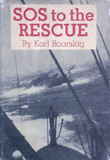 |
Baarslag, Karl. SOS to the Rescue. 1st printing. NY: Oxford University Press. 1935. hardcover. isbn: none. scarcity: fairly common.
The author, a former wireless operator himself, describes the history of wireless at sea starting with the early pioneers and passing through the late 1920s. Some of the most famous sea disasters in history are included. There is one chapter, 39 pages, on the Titanic.
If you are decently up on your Titanic lore, you can probably name the two wireless operators aboard, Jack Phillips and Harold Bride. But can you name the wireless man who was credited with the first maritime wireless distress call that resulted in a significant number of the passengers being saved? It was Jack Binns of the steamship Republic rammed by the Florida in 1909.
The story of Binns and many other wireless men is told in this fascinating look at the use of wireless on ocean going vessels.
Other chapters describe the stories of the wireless man on the Empress of Ireland, the wireless man on the Antinoe, the Vestris and the Tashmoo - all ships involved in sea disasters. They were Ronald Ferguson, Arthur Kimberly Evans, Michael J. O’Loughlin, and Arthur Finch respectively. When disaster struck, these men all stayed on their sets for as long as they had power to send. Their stories, and many more are recounted.
Baarslag was dismayed that these heroes of the sea were being all but ignored by history. His book is an attempt to redress that wrong by telling the stories of the wireless men along with the history of wireless at sea. The stories of sea disasters in this book are all told from the wireless man’s point of view. The author personally knew many of these men, or at least had a chance to speak with most of them from an insider’s perspective. As a result his insights into the lives of these men is priceless.
Baarslag describes how CQD became the first distress signal, and why it was later changed to SOS. He disproves the claim made in many books that the SOS call was first used on the Titanic. Actually, SOS came into common use as early as 1909 and was used in that year for the first time by an American ship in distress, the Arapahoe by her operator T.D. Haubner.
This is an excellent overview on the history of wireless at sea, the author has preserved for history the names of men (and women) who might otherwise have been forgotten..
There is a modern reprint in wraps by 7 C’s Press, which probably includes just the Titanic chapter from this book.
Coverage image courtesy of Kalman Tanito.
|